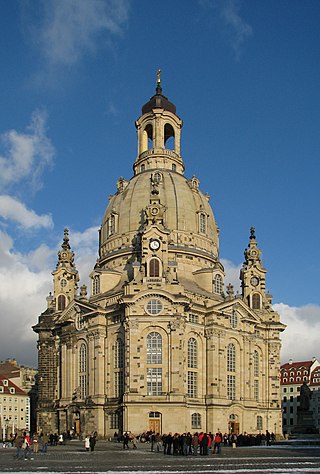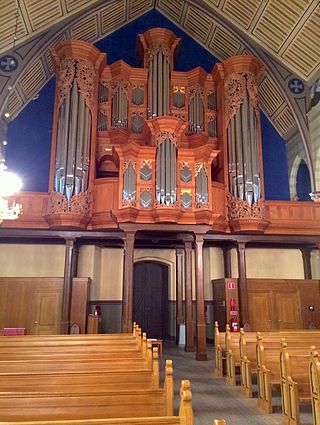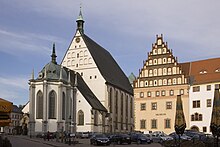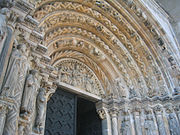
The Frauenkirche in Dresden is a Lutheran church in Dresden, the capital of the German state of Saxony. Destroyed during the Allied firebombing of Dresden towards the end of World War II, the church was reconstructed between 1994 and 2005.

Freiberg is a university and former mining town in Saxony, Germany. It is a Große Kreisstadt and the administrative centre of Mittelsachsen district.

Hildesheim Cathedral, officially the Cathedral of the Assumption of Mary or simply St. Mary's Cathedral, is a medieval Roman Catholic cathedral in the city centre of Hildesheim in Lower Saxony, Germany, that serves as the seat of the Diocese of Hildesheim. The cathedral has been on the UNESCO World Cultural Heritage list since 1985, together with the nearby St. Michael's Church because of its unique art and outstanding Romanesque architecture.

Dresden Cathedral, or the Cathedral of the Holy Trinity, Dresden, previously the Catholic Church of the Royal Court of Saxony, called in German Katholische Hofkirche and since 1980 also known as Kathedrale Sanctissimae Trinitatis, is the Catholic Cathedral of Dresden.

Gottfried Silbermann was a German builder of keyboard instruments. He built harpsichords, clavichords, organs, and fortepianos; his modern reputation rests mainly on the latter two.
Zacharias Hildebrandt was a German organ builder. In 1714, his father Heinrich Hildebrandt, a cartwright master, apprenticed him to the famous organ builder Gottfried Silbermann, brother of Andreas Silbermann in Freiberg. In 1721, Hildebrandt finished his masterpiece, the organ of the Nikolaikirche of Langhennersdorf, a small village near Freiberg. Afterwards he built an organ in Störmthal near Leipzig and from 1724 to 1726 an organ in Lengefeld. On this project, a dispute developed with Gottfried Silbermann, who treated him as a rival and sued him. The dispute was settled by an agreement in which Hildebrandt obliged himself to take over only orders rejected by Silbermann. Therefore, he moved his work to the region near Leipzig and to Thuringia. J.S. Bach thought Hildebrandt was the best organ builder of his time.
Prelude (Toccata) and Fugue in E major, BWV 566 is an organ work written by Johann Sebastian Bach probably during his 4 month-stay at Lübeck or afterwards in the winter of 1705–1706. It comprises five sections and is an early work in grand form of Bach.

The 140-kilometre-long road, the Silver Road is the first and longest holiday route in the German Free State of Saxony. Against the background of the importance of mining in the history of Saxony, the road links those sights and tourist attractions of the Ore Mountains and its foreland that relate to the centuries-old mining and smelting industries of the region.

Riga Cathedral formally The Cathedral Church of Saint Mary, is the Evangelical Lutheran cathedral in Riga, Latvia. It is the seat of the Archbishop of Riga.

The Sophienkirche was a church in Dresden.

The North German baroque organ in Örgryte Nya Kyrka is a pipe organ in Gothenburg. It was built within a research project at GOArt, University of Gothenburg and dedicated on August 12, 2000. The goal of the project was to recreate the construction techniques and design philosophies of 17th-century German organbuilder Arp Schnitger. Even though the instrument was built in the style of this single builder it was not modeled after a single instrument. No single model could be used since no large Schnitger organ has been preserved in original condition. The construction of the organ was carried out by an international team of organ builders. Henk van Eeken was responsible for the design and the technical drawings, Munetaka Yokota for the pipe work and Mats Arvidsson oversaw the building process. The instrument contains almost 4000 pipes and is the largest existing organ tuned in quarter-comma meantone.
Pipe organs that are tuned in meantone temperament are very rare in North America. They are listed here, by type of temperament and sorted by date of construction. North America is defined here as Canada, the United States of America and Mexico. All instruments listed are playable but unplayable instruments may be added with a note.
Andreas Silbermann was a German organ builder, who was involved in the construction of 35 organs, mostly in Alsace. Andreas also established the Silbermann family tradition of organ building, training his brother Gottfried and his son Johann Andreas in the profession.

The New Town Church is a main Lutheran parish church in Hanover, Germany. Its official name is St. John's Church of the court and city in the New Town at Hanover. The Baroque church was built in 1666–70 and is one of the oldest Protestant aisleless churches in Lower Saxony, conceived for the sermon as the main act of the Lutheran church service. Mathematician and philosopher Gottfried Wilhelm Leibniz and Field Marshal Carl August von Alten are buried here.

St. Mary's Church in Marienberg in the German state of Saxony is an Evangelical-Lutheran church in the southeast of the county of Erzgebirgskreis. It is the most recent of the three Ore Mountain Late Gothic hall churches.

Störmthal is a village, part of Großpösna in the Leipzig district in Saxony, Germany. It is known for its church in Baroque style. The organ, an early work by Zacharias Hildebrandt, was played and inaugurated by Johann Sebastian Bach and is still in mostly the condition of Bach's time.

The Church of Reinhardtsgrimma is a Lutheran parish church in Reinhardtsgrimma, a part of Glashütte in Sächsische Schweiz-Osterzgebirge in Saxony, Germany. It contains a pipe organ built in 1731 to the designs of Gottfried Silbermann.

St. Jakobi is the name of a Lutheran parish and church in Hannover-Kirchrode, Lower Saxony, Germany. It dates back to the 12th century, was remodeled in Baroque style, destroyed in World War II, and restored.
Hans Otto was a German organist, harpsichordist and cantor.

Tobias Heinrich Gottfried Trost was a leading Thuringian organ-builder. Johann Sebastian Bach held him in high regard. His organs in the city church of Waltershausen (1722–1730) and in the Altenburg Palace (1735–1739) are amongst the best-known Baroque organs of middle-Europe, and are largely preserved in their original state.



















